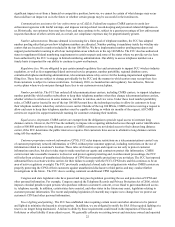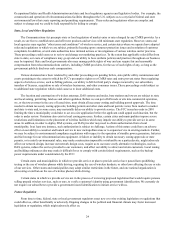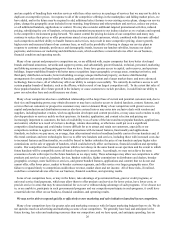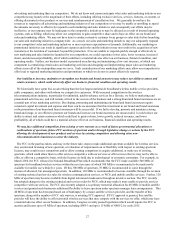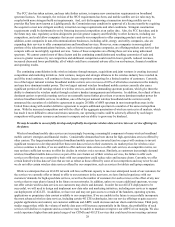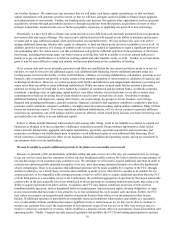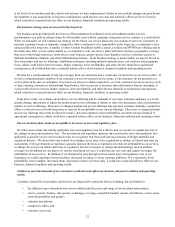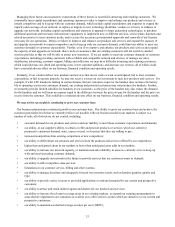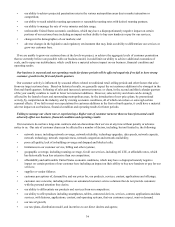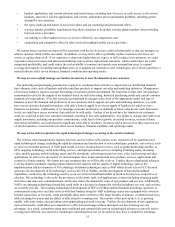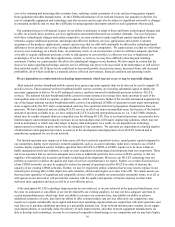Metro PCS 2011 Annual Report Download - page 39
Download and view the complete annual report
Please find page 39 of the 2011 Metro PCS annual report below. You can navigate through the pages in the report by either clicking on the pages listed below, or by using the keyword search tool below to find specific information within the annual report.28
The FCC also has taken actions, and may take further actions, to impose new construction requirements on broadband
spectrum licenses. For example, the revision of the WCS requirements has been, and mobile satellite service rules may be,
coupled with more stringent build out requirements. And, as it did in approving a transaction involving satellite service
provider SkyTerra (now known as LightSquared), the Commission may condition its approval of a license transfer by requiring
the acquirer to meet new stringent ancillary terrestrial coverage requirements and other conditions. Stringent construction
requirements could be detrimental to us by fostering increased competition at an earlier date. Also, the FCC has taken, and in
the future may take, regulatory actions designed to provide greater capacity and flexibility to other licensees, including our
competitors, and could allow companies that are not currently our competitors to offer competing products and services. In
addition, some companies in non-telecommunications businesses, including cable, energy and utility companies, also are
expanding their services to offer communications and broadband services. Moreover, some companies in non-regulated
portions of the telecommunications business, such as Internet search engine companies, are offering products and services that
compete with our more highly regulated services. Some of these companies are offering these services using unlicensed
spectrum. We cannot control most of these factors and the continuing consolidation and resulting economies of scale and
access to greater resources by our competitors and additional competition could result in lower growth, reduced revenues,
increased churn and lower profitability, all of which could have a material adverse effect on our business, financial condition
and operating results.
The continuing consolidation in the wireless industry through mergers, acquisitions and joint ventures is creating increased
competition and marketing initiatives. Joint ventures, mergers and strategic alliances in the wireless industry have resulted in,
and if the trend continues, will continue to foster, larger competitors competing for a limited number of customers. Currently,
two of the largest national wireless broadband mobile carriers serve in excess of 60% of all wireless customers in the industry
and may have dominant market power. The two largest national wireless broadband mobile carriers currently also earn a
significant portion of all earnings related to wireless services, and hold commanding spectrum positions, which give them the
ability to dominate the wireless market through exclusive handset arrangements and otherwise. In addition, the refusal of these
dominant carriers to provide roaming services on reasonable terms further gives them even more dominant market power for
wireless broadband mobile services. In addition, one of the largest national wireless broadband mobile carriers recently
announced the execution of a definitive agreement to acquire 20 MHz of AWS spectrum in most metropolitan areas in the
United States along with another definitive agreement to acquire additional spectrum in a number of the same metropolitan
areas. With the increased competition and with the effect of the aggregate penetration of wireless services in all markets, which
has made it more difficult to attract and retain customers, our operating results could be adversely affected by such larger
competitors with greater resources and means to compete and our ability to grow may be hindered.
We may be unable to successfully develop and profitably incorporate wireless data services into our service offerings in
the future.
Wireless broadband mobile data services are increasingly becoming a meaningful component of many wireless broadband
mobile carriers' strategies and financial results. Considerable demand has been shown for high-speed data services offered by
other carriers. The largest national wireless broadband mobile carriers have invested (and we expect will continue to invest)
significant resources to develop and deliver these new data services to their customers. As market prices for wireless voice
services continue to decline, if we are unable to offer such new data services or offer such services on competitive terms, we
may not have sufficient revenue to offset the decline in wireless voice revenues. Similarly, as customers increasingly demand
wireless broadband mobile data services as part of the core feature set of their wireless services, the failure to offer such
services or offer them on a competitive basis with our competitors could reduce sales and increase churn. Currently, we offer
certain limited wireless data services that are not as robust as those offered by some of our competitors and may never be and
we do not offer certain wireless data services offered by our competitors, such as services for tablets and laptop computers.
While we anticipate that our 4G LTE network will have sufficient capacity to meet our anticipated needs of our customers for
the services we currently offer or intend to offer to our customers in the near term, we have limited experience with our
customers' demands for high-speed data services, as well as the number of customers for such services or the effect of any new
services that we may plan to launch in the future on our networks. In addition, unless we secure additional spectrum, we may
not offer certain wireless data services our customers may desire and demand. In order for our 4G LTE deployment to be
successful, we will need to design and implement new data sales and marketing initiatives, including new services to support
our deployment of 4G LTE. In addition, we have not and may not gain access to certain of the handsets, operating systems,
applications or proprietary data content available to our competitors. If we are unable in the future to successfully incorporate
the most advanced wireless data services, including certain 4G LTE technologies, into our service offerings or gain access to
popular applications and content, our customer additions and ARPU could decrease and our churn could increase. Third party
studies suggest that, while the volume of mobile data users will increase exponentially in the future, the profitability of such
services will decline or evaporate and as a result we may be unable to maintain or improve our ARPU or our margins. We also
could experience higher than anticipated usage of our CDMA and 4G LTE services that could result in not meeting customer






